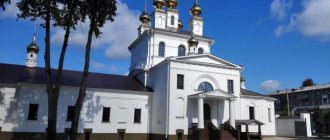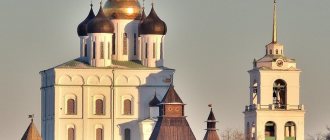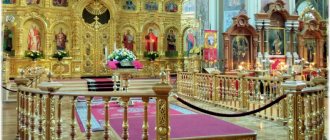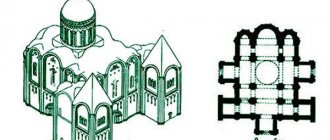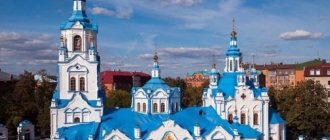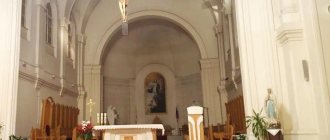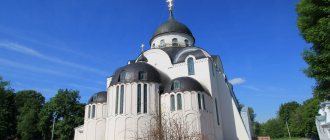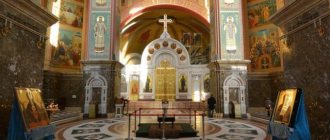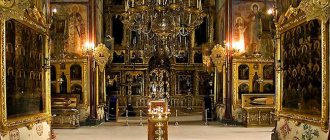| Omsk Assumption Cathedral. Postcard from the late 19th – early 20th centuries |
Omsk Cathedral in honor of the Dormition of the Blessed Virgin Mary
, cathedral of the Omsk diocese
- Altar: Dormition of the Blessed Virgin Mary (main); St. Nicholas the Wonderworker (southern) [1], equal to the Apostles. Mary Magdalene (northern) [1]
- Address: Russia, Omsk, st. International, 12
- On the map: Yandex.Map, Google map
Since 1878, the idea of expanding existing churches was actively developed in Omsk: the fortress cathedral in the name of the Resurrection of Christ, the Military Nicholas Church.
However, the opinion about the need to build a new cathedral prevailed. The first stone for the foundation of the cathedral was laid on July 16, 1891 by Tsarevich Nikolai Alexandrovich in the former city grove in the center of Omsk. The temple was built with funds from the Omsk Resurrection Cathedral, with the assistance of the Holy Synod and with donations from parishioners and individuals [2].
The author of the architectural project was Ernest Frantsevich Virrich. He took as a basis the design of the Church of the Savior on Spilled Blood in St. Petersburg, but the Omsk temple was not an exact copy of the St. Petersburg one, but a creative reworking, which is a common phenomenon in church architecture. The size of the temple and the architecture of the Assumption Cathedral were unique in many ways. In particular, 30 types of bricks of different colors were used during its construction.
The area of the cathedral was 1518 meters, the height of the bell tower to the cross apple was 44 meters, the height of the cross was 3 meters, the diameter of the dome was 15 meters. The five-domed cathedral with a powerful central dome and a high hipped bell tower looked solemn and monumental.
The cathedral, built in the style of Russian architecture of the 17th century, amazed with its amazing logic and harmonious combination of proportions and styles. E.F. Virrich managed to combine official Russian-Byzantine and folk styles in his project. In particular, the ratio of a huge (onion-shaped) dome and small domes goes back to the architecture of Byzantium, and from the Russian style there are numerous kokoshniks, hipped porches, melons, framing of arched openings with platbands, etc.
The cathedral was originally called the Church of the Ascension
, it was renamed into the Assumption Cathedral after the creation of the Orthodox diocese in Omsk in 1895.
On September 9 [3] 1898, the first Omsk bishop Gregory (Poletaev) consecrated the cathedral.
In 1910, children's playgrounds were opened in the garden near the cathedral, bringing together up to 200 children, with whom teachers worked.
According to information from 1914, within the parish there was a parochial school (opened in September 1897) and 2 parochial schools.
The staff of the clergy was: a cathedral archpriest, a clergyman, two priests, a protodeacon, two deacons, two subdeacons and two psalm-readers.
After the revolution
| The altar wall of the Omsk Assumption Cathedral, which survived the explosion, 1935 |
At the end of 1920, the cathedral was transferred to the renovationists.
But the renovationists were unable to gather parishioners. Since 1923, the temple was mostly empty; by 1933, the domes were dismantled and the bells were removed for the needs of industrialization; in 1934, all church utensils were transferred to the newly organized museum of atheism.
In 1934, Omsk became the administrative center of the Omsk region. The regional party committee was located opposite the temple. Ideological opponents found themselves in the same square. In 1934, the party leadership of the region decided to convert the cathedral into an opera house. The acoustics inspection commission gave a positive conclusion, but the fate of the temple was decided differently.
On February 17, 1935, the presidium of the Omsk Regional Executive Committee, at the proposal of the head of the Omsk NKVD Salyn, decided to demolish the building. The NKVD officers intended to use the bricks of the cathedral for the construction of a new building for the regional People's Commissariat of Internal Affairs. However, after the explosion, the temple disintegrated not into bricks, but into large blocks unsuitable for construction. The altar wall survived the explosions. The former Bishop's Garden, located around the cathedral, became the Pioneer Garden. Over time, a decorative puddle was made at the base of the temple, and in 1996, a city fountain was made.
Recreation of the cathedral
| Omsk Assumption Cathedral, view from the south. Photo by O. Nesterov, December 30, 2007. |
In 1999, a Worship Cross was installed on the site of the cathedral.
On July 11, 2005, the government of the Omsk region decided to recreate the historical and cultural monument of the Omsk Irtysh region - the Assumption Cathedral.
On July 16, 2005, while excavating the foundation of the blown-up cathedral, archaeologists discovered the burial of an Orthodox bishop. In the tomb, which was discovered in a secret underground room under the porch of St. Nicholas, an icon, pieces of fabric, body remains and other finds were found indicating that this is the burial of Archbishop Sylvester. Later, the belonging of the relics to the Archbishop of Omsk and Pavlodar Sylvester was confirmed by the results of the examination.
On October 14, 2005, a ceremony was held to install the foundation stone at the foundation of the Assumption Cathedral, symbolizing the beginning of construction of the temple. During the service, Metropolitan Theodosius (Protsyuk) of Omsk and Tara placed a reliquary with the relics of the holy martyr Sylvester (Olshevsky) in the foundation stone.
On January 14, 2006, the installation of the pile foundation was completed, and the construction of brick walls began. On July 27 of the same year, thirteen bells weighing 5.5 tons were consecrated.
On January 6, 2007, on the eve of the Nativity of Christ, these bells sounded for the first time in the new bell tower. On March 30, the main dome of the cathedral, weighing 15 tons, was raised. On April 16, a cross was installed on it. On May 31, ceramic icons were brought to the construction site and became decorations on the outer walls of the temple. On July 2, the installation of the iconostasis began.
On July 15, 2007, the consecration of the recreated cathedral took place.
Statistics
- 1900 - 4919 parishioners (3144 m.p., 1775 w.p.); heterodox and non-Orthodox people - 230 people (127 m.p., 103 zh.p.), Old Believers - 4 people (2 m.p., 2 zh.p.)
- 1914 - 1063 parishioners (486 m.p., 577 w.p.); Gentiles, non-Orthodox and sectarians - 318 people (167 m.p., 151 w.p.). There are 358 baptisms per year, up to 25 marriages, and up to 413 burials.
Schedule of services of the Assumption Cathedral in Omsk
Services in the Omsk Cathedral are held daily. In addition, daily (at 15:00) there are prayer services at the shrine with the relics of the holy martyr Sylvester.
Schedule of services in the Assumption Cathedral in Omsk on the official website
©
Good to know
For the initial construction of the temple at the end of the 19th century, the necessary funds were collected not only by the city authorities and the Holy Synod, but also by parishioners from all over the empire. The State Treasury took over the interior decoration, and the iconostasis was imported with the personal money of Nicholas II. In total, more than 125 thousand rubles were spent on construction and decoration. In April 2005, a grandiose exhibition project dedicated to the Assumption Cathedral of the late 19th century was launched in the Omsk region. The exhibition included rare exhibits of ancient Russian architecture, church vestments, books and the first photographs of the temple.
Today, on the square adjacent to the cathedral, various festive events of city and state significance are annually held, for example, the May 9 parade. Also, with recent measures, the main road to the temple, by decree of the regional government, has become the main venue for sports competitions.
Story
The history of the Omsk Cathedral began at the end of the 19th century. In the summer of 1891, construction of the landmark began, and the first stone for the foundation of the temple was laid by the future Emperor Nicholas II. The original temple-monument designed by E. F. Virrich was erected in the fall of 1898; the St. Petersburg Church of the Savior on Spilled Blood by A. Parland was taken as a model; the architectural style was neo-Byzantine with pseudo-Russian elements. The consecration of the temple was carried out under the leadership of Bishop Gregory of Omsk. In 1905, John of Kronstadt visited the cathedral with his sermon.
In 1918, after the adoption of the decree “On the separation of church from state and school from church,” parishioners were no longer allowed into the cathedral. Arrests and murders of clergy began, and services in the temple were stopped. For several years the cathedral building was empty, and in 1933 the bells were removed from the temple and sent for melting down. At that time, a proposal was put forward to rebuild the cathedral into an opera house, but it was never implemented. In 1935, during the rule of the Soviets, they decided to demolish the cathedral and it was blown up. A recreation park was built in its place.
In 1999, a cross was erected on the site of the former cathedral, and in 2005, a decision was made to restore the temple entirely from photographs (with money raised exclusively by parishioners). In the autumn of the same year, the foundation stone of the new cathedral was laid, and in the winter of 2006, construction of brick walls began. The Assumption Cathedral was re-consecrated in 2007, at the same time the square received its modern name - Cathedral, now all the main city celebrations take place here. New church bells, 13 in number and weighing more than 5 tons, were brought from the Urals, and special red brick for decoration came from the Baltic states. In the spring of 2007, its central dome and cross were installed on the cathedral, as well as unique ceramic icons, which are the main decoration of the building’s facade.
The Omsk Cathedral of the Assumption of the Blessed Virgin Mary in Omsk is included in the list of great temples of world religious culture; it is one of the most famous historical places in the country.
© Ninara
Sunday School
Currently, the cathedral operates a Sunday school for children and adults, which is attended by more than 50 people under the leadership of the confessor, Priest Oleg Ganzhenko. On various religious holidays, such as Christmas or Easter, students here prepare a gala concert for everyone.
Disciplines studied:
- Introduction to the Law of God;
- Orthodox Worship;
- Holy Scripture of the Old Testament;
- Holy Scripture of the New Testament;
- Fundamentals of Christian Morality;
- History of the Christian Church;
- Orthodox Catechism;
- Christian ethics;
- arts and crafts, drawing, applique, modeling, handicrafts.
Sunday school opening hours: every week on Sundays from 11:30 to 14:00.
Description
A detailed description of the cathedral of the 19th century has been preserved (in 2007 the temple was restored from photographs, and does not repeat the original in all details). The area of the cathedral was 1518 m², the height of the bell tower to the apple of the cross was 44 meters, the height of the cross was 3 meters, the diameter of the dome was 15 meters.
At that time, the church had a complex space-planning solution that preserved the traditional composition: an altar, the middle part of the temple, a refectory and a vestibule with a bell tower. The church was installed on a high ground floor, made of brick (30 types of patterned bricks of different colors were used in construction).
The architectural solution is cross-shaped in section. The five-domed structure consists of helmet-shaped domes rising on cylindrical drum towers cut through by arched windows. Above the altar there is a pentagonal concha. The roof of the refectory is gable.
An octagonal lantern with windows and pilasters at the corners is installed above the dome. On the bell tower there is the same lantern with a belt (interception) at the top. The heads are installed on the dome, altar, chapel and bell tower. Eight-pointed crosses.
Unfortunately, no examples of the temple's decoration have survived to this day. It is only known that the decorative patterns repeated the examples of Moscow architecture of the 17th century. Rusticism was used in the basement of the building. Niches, curbs, blades, and complex cornices in several tiers were used as decorations. The semi-circular windows are decorated with platbands, and on the ground floor they are enclosed in metal bars.
The bell tower is three-tiered, with rectangular window openings. The bell tier is octagonal, with arched openings, and ends with a keel-shaped covering.
The temple was painted by the artist Yemtsov. The iconostasis with all the icons was made in the workshop of the Yekaterinburg merchant A.P. Kozhevnikov.
Music
A children's and youth choir was founded at the Cathedral of the Assumption of the Blessed Virgin Mary in Omsk in the fall of 2010. Its creation was timed to coincide with the celebration of the Exaltation of the Honest and Life-Giving Cross of the Lord.
The singing of the choir can be heard in Sunday school classes every Saturday from 15:00 to 17:00, on Sundays after the Divine Liturgy, as well as at every Sunday or holiday service.
© Cathedral of the Assumption of the Blessed Virgin Mary
Notes[ | ]
- ↑ 1 2 3 4 5
Based on materials collected by Omsk State University students
(unspecified)
(inaccessible link). Retrieved September 8, 2009. Archived March 4, 2009. - ↑ 1234
Based on materials from the Open Orthodox Encyclopedia Tree Archival copy dated June 9, 2008 on the Wayback Machine - ↑ 123
Information from the Official Website of the Omsk City Administration - ↑ 12
Based on materials from the Moscow Patriarchate - ↑ 12345
Full information about the opening and illumination of the cathedral on the Omsk Governorate portal - ↑ 1 2 3
Information from the Official website of the Administration of Omsk
(unspecified)
(inaccessible link). Access date: September 8, 2009. Archived December 4, 2008. - ↑ 12
Information from the Website of the Ministry of Culture of the Omsk Region. - The information was commented in detail by the coordinator of the “Return” project Yu. Bondarenko on the portal of the Orthodox news agency Russian Line
- ↑ 1 2 3 4 Shipilova T.
Assumption Cathedral: Return of the Shrine // Omskaya Pravda. — 07/31/07. - Assumption Cathedral, Omsk city - » Clergy (undefined)
. Access date: October 21, 2022. - Vasilyeva S.
The temple was built // Omsk Bulletin: newspaper. — 07/11/07. Archived March 7, 2016. - A series of exhibitions “Assumption Cathedral: with faith in the future” opened in Omsk // Blagovest-info, 04.04.2007
Relics
During archaeological excavations at the site of the former bombed temple, an ancient burial place of Bishop Sylvester was found. His remains were in a secret room along with icons. At the site of the find, regular services immediately began to be held, and later even religious processions began to be held here.
One of the main shrines of the five-domed temple - a shrine with the relics of the canonized Archbishop Sylvester - was installed in the cathedral in 2009 and is accessible to pilgrims.
Biography of the Hieromartyr Sylvester
Hieromartyr Sylvester Olshevsky was born in 1860 in the small village of Kosovka, Kyiv province, into the family of deacon Lev Olshevsky. All the saint's childhood years were surrounded by various feelings from Orthodox services. Having become an adult clergyman, Sylvester often traveled to various churches in the Chelyabinsk district, making many efforts to restore and improve the lives of parishioners.
During the revolution, Archbishop Sylvester, like many other church workers, was arrested and sent to prison. There he was tortured for a long time and demanded to repent, but he held tightly to his faith. Then the atheists created a kind of crucifixion - nailing his hands to the floor, and then burning his body with red-hot rods, finally piercing him right in the heart on February 26, 1920.
In 1998, Sylvester was canonized by the Omsk-Tara diocese. In 2000, he was included in the list of Russian new martyrs.
Assumption Cathedral on Google panoramas of Omsk
Shrines
The revered image of the cathedral of the 19th century was the icon of the holy and blessed princess Anna Kashinskaya with particles of the saint’s relics.
In 1913, Bishop Andronik (Nikolsky) updated the Omsk iconostasis with Novgorod icons. Copies of miraculous icons were sent to Omsk: the Tikhvin Icon of the Mother of God, the holy icons of the Great Martyr Barbara and the Venerable Euphrosyne of Polotsk, consecrated on the relics of the Saints and containing their particles.
The main shrine of the cathedral of the 21st century is the relics of Archbishop Sylvester, found during excavations, canonized by the Moscow Patriarchate in November 1998 as a new martyr of Russia. In addition, Metropolitan Clement gave the cathedral an image of the Kazan Icon of the Mother of God with a personal signature with the blessing of Patriarch Alexy II.
Website: https://omsk-sobor.ru
Wikipedia
How to get to the Assumption Cathedral in Omsk
The Cathedral of the Assumption of the Blessed Virgin Mary is located in the central part of Omsk. The closest stop to Cathedral Square is “CDC Mayakovsky”, you can get there by buses No. 20, 22, 23, 24, 25, 33, 59, 62, 63, 69, 73, 78, 94, 95, 109, 110, 336, trolleybuses No. 2 and 4, minibuses No. 31N, 64, 94, 212, 225, 275 (M), 302, 307, 323, 331, 225, 346, 385, 387, 394, 424, 434, 470, 500 , 503, 514, 903. Transport to the place from the railway station - buses No. 24, 69, 110, minibus No. 307.
Omsk public transport traffic patterns
You can also use taxi services in Omsk: Yandex. Taxi, Uber, Gett, Maxim, taxi Lucky, Citymobil, Unis-Lada, Kopeyka, Seven, Leader, Bonus, Taxi Home, Eight, Instantly, Taxi Driver, Pyatnashka, Meridian, taxi Inomarka, taxi Renault, taxi Russia and others .
Video about the Assumption Cathedral in Omsk
Funds for construction[ | ]
XIX century[ | ]
The first funds for the construction of the temple were collected by parishioners to expand the Resurrection Cathedral. In addition, public funds and personal donations from Emperor Nicholas II were invested. The Holy Synod covered the missing amount.
In 1898, the State Treasury allocated another 10,000 rubles for the exterior and interior decoration of the church. The Emperor sent 5,000 rubles personally. In addition, they were later given a set of highly valuable altar plates for the cathedral.
In total, 125,000 rubles were spent on the construction and decoration of the temple in those years[1].
XXI century[ | ]
The board of trustees of the revived cathedral was personally headed by the governor of the Omsk region L. Polezhaev. In just two years, donations from parishioners of Omsk churches for the construction of the Assumption Cathedral amounted to several tens of millions of rubles[5].
Board of Trustees[ | ]
The Board of Trustees, which monitored the revival of the temple in 2005-2007, included:
- Polezhaev, Leonid Konstantinovich. Governor of the Omsk Region, Chairman of the Board of Trustees
- Adabir, Anatoly Nikolaevich. Secretary of the Political Council of the Omsk regional branch of the political party "United Russia", head of the administration of the Oktyabrsky district of Omsk
- Belyaev, Alexander Nikolaevich. Director of NPO Mir LLC
- Berezovsky, Vladimir Alexandrovich. General Director of Federal State Unitary Enterprise OPO "Irtysh"
- Varnavsky, Vladimir Alekseevich. Chairman of the Legislative Assembly of the Omsk Region
- Goering, Gennady Ivanovich. Rector of Omsk State University named after. F. M. Dostoevsky
- Kivich, Alexander Alexandrovich. Deputy of the Omsk City Council, President of the food and processing industry enterprises of the Omsk region, General Director of OJSC Omsk Bacon
- Kozlova, Natalya Konstantinovna. Chairman of the Board of the Omsk regional public organization "Center of Slavic Traditions"
- Kokorin, Valery Mikhailovich. General Director of the non-profit partnership of construction and trade organizations "Agrostroykomplekt"
- Protsyuk, Igor Ivanovich. Metropolitan of Omsk and Tara Theodosius.
- Putintsev, Vitaly Petrovich. President of the Omsk Regional Union of Entrepreneurs
- Radul, Vladimir Vladimirovich. Minister of Culture of the Omsk Region
- Svatkov, Boris Semyonovich. President of the Union of Business Trade of Omsk and the Omsk Region, General Director of OJSC VEC Omtor
- Stepanov, Valery Nikolaevich. Chairman of the Property Committee of the Legislative Assembly of the Omsk Region, President of OJSC Omskpromstroybank
- Tretyakov, Alexander Georgievich. Chairman of the Committee on Education, Culture and Youth Policy of the Legislative Assembly of the Omsk Region
- Tryapitsina, Irina Gennadievna. President of the “Road to Life” Foundation for Social Support of Orphans, Director of the Omsk Region State Enterprise “Omsk Center for Technical Inventory and Land Management”
- Frolova, Natalya Konstantinovna. First Deputy Chairman of the Government of the Omsk Region, Minister of Finance of the Omsk Region
- Tsareva Raisa Nikolaevna. Director of the state cultural institution of the Omsk region "Omsk State Regional Scientific Library named after A. S. Pushkin", Chairman of the Board of the Omsk regional public organization "Public Coalition of the Omsk Region"
- Shishov, Oleg Vladimirovich. Chairman of the Financial and Budgetary Policy Committee of the Legislative Assembly of the Omsk Region, Director of the NPO Mostovik
- Schrader, Viktor Filippovich. Mayor of Omsk
Literature[ | ]
- Goloshubin I.S.
Reference book of the Omsk diocese. - Omsk, 1914. - pp. 17-18, 558, 1082, 1095-1197, 1163, 1185, 1192, 1199, 1215, 1219. - Ryzhenko V. G.
Russian Orthodoxy in Siberia. - Omsk, 1995. - T. Church and Revolution: “Omsk Diocesan Gazette” about the March events of 1917. — P. 138-141. - Lebedeva N.I.
In one’s suffering one receives an imperishable crown // Omsk Diocesan Gazette. - April 1998. - Shipilova T.
Assumption Cathedral: Return of the Shrine // Omskaya Pravda: newspaper. — 07/31/2007. - Omsk Assumption Cathedral: popular science. Sat. / A. M. Losunov et al.; Archaeological Conservation Foundation. heritage. - Omsk: [b. i.], 2007. - 302 p.
- Assumption Cathedral. Omsk shrine: [album / N.I. Lebedeva and others. Government of Omsk. region, M-vo culture Om. region]. - Omsk: Rus, 2007. - 239 p.
- Losunov A. M.
Assumption Cathedral: The unknown about the known: [Cathedral of the Omsk Region] // Questions of methodology and history in the works of young scientists: Collection. scientific Art. Vol. 9. - Omsk, 2006. - P. 180-197.
